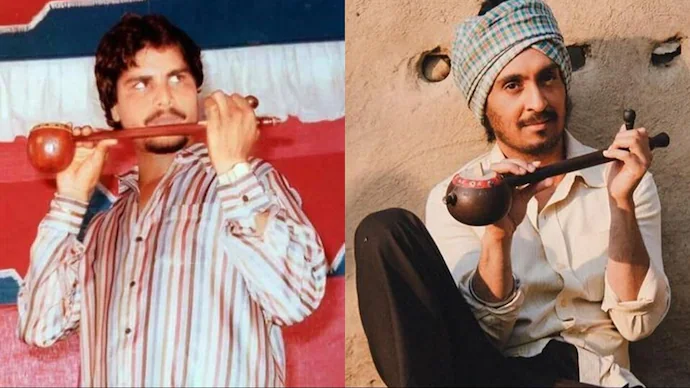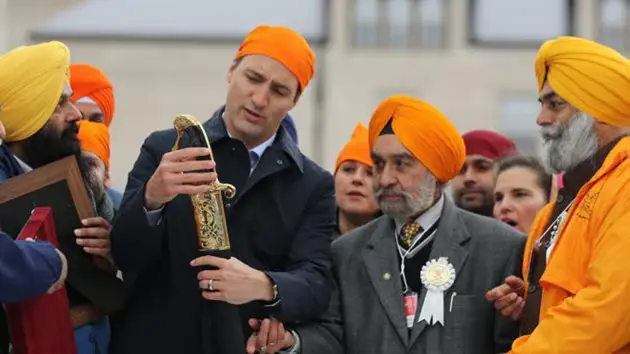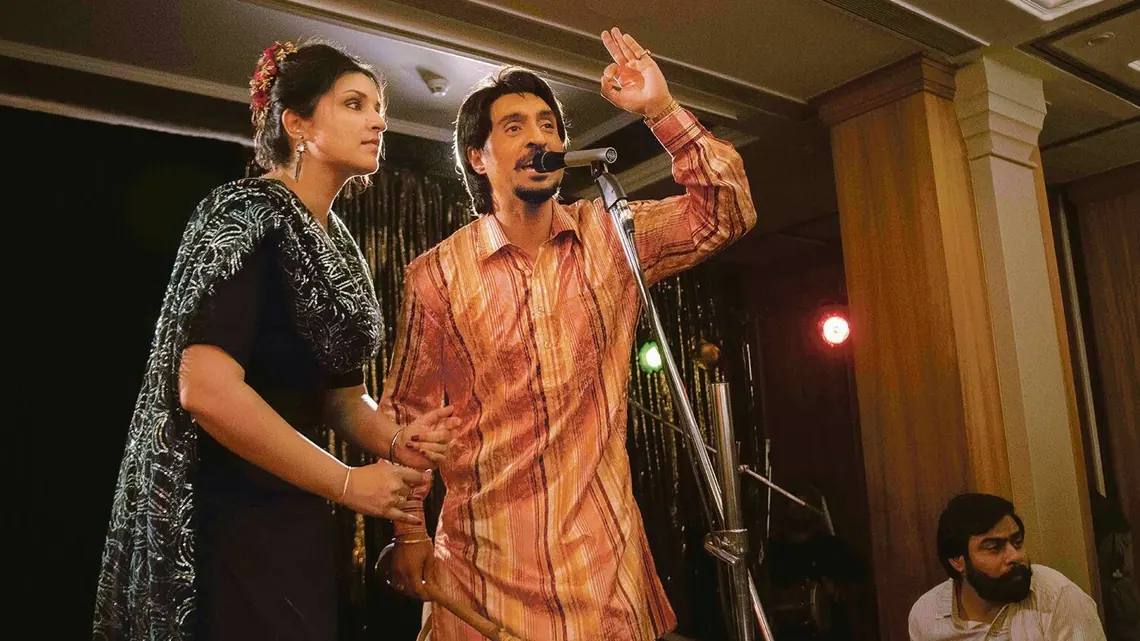The movie Amar Singh Chamkila opens with its climax scene. Amar Singh Chamkila played by Diljit Dosanjh and Amarjot Kaur played by Parineeti Chopra are shot multiple times by Khalistani assassins for allegations of indecent lyrics in some of his songs which he wrote and composed as well. Director Imtiaz Ali had crafted the scene with utmost precision to make sure that he is on the right side of the documentation and historical accuracy which is based on multiple eyewitnesses present on that fateful day of 8th March, 1988.

Ironically (and symbolically), the exact same spot of the village Mehsampur (Dist Jalandhar) was chosen to recreate the events which arguably stand as the epitome of religious extremism of the dark 80s and 90s in Panjab. Another symbolism embedded into that scene was the veil of oblivion drawn over the characters of assassins who rained bullets from their Kalashnikovs and Stens on the most popular and the most sold-out artist duo that the Punjabi music industry has scene till date. Oblivion is what the Khalistanis (who belong to the land of the pure) have dwelled into since the culmination of militancy in the north western state of India in the mid-90s.
The movie has been a great success despite not featuring in cinemas which in itself is testimony of changing times. It also showcases different narratives and mindsets prevalent amongst various classes of masses of the violence ridden contemporary Panjab. What was missing was the acknowledgement of the justification that the Khalistani outfits gave or at least used to give for the assassination of Amar Singh and Amarjot Kaur. Imtiaz too refrained to mark their existence as all such characters are merely portrayed in a dark backdrop and with hazy faces, much like their irrelevant agenda corroding over the decades.
A generation was lost at the hands of extremists in Panjab. Thousands of youths were misled by politicians, radicalised by clergy and pushed into militancy in that era which Panjabis simply call the ‘Attwadi Daur’. Thousands more innocent people were killed by such terrorists in vicious and ruthless attacks aimed to maim the religious harmony which was earlier jolted in the monsoon of 1947. This time it was to put a wedge between the Hindu-Sikh faith which was naturally unifying and undeniably native. Pumped by Gen Zia’s militancy push and use of proxy wars as state instruments, separatist elements wreaked havoc for a decade and a half in the land whose destiny seemed to be intertwined with conflicts, struggles and undeterred resilience to prevail and flourish even in the direst of times which the Khalistanis offered.
Just five days before this assassination, Panjab had suffered its worst massacre of the militancy era. Thirty-five people were butchered in the village of Sahri of Hoshiarpur district during the Holi and Hola Mahalla celebrations by three Khalistani terrorists who opened indiscriminate fire from their automatic assault rifles at the villagers and visitors who had congregated at Holi mela at the Thakur Dwara (common worship place) of the village. Men, women, children and elderly lay dead. Many bodies of people were found few miles away who must have fled under the adrenaline rush after getting shot but later succumbed to the wounds. Also lay dead were Hindus and Sikhs, if that’s how it has been normalised to classify the living and the dead these days. As has always been the case with the orthodox and right-wing extremist forces, interfaith harmony stands as the primary threat to their flourishment and propagation of agenda. Pakistan ISI and Mullah setup was instrumental in providing the logistics and training to the Sikh separatists across the then permeable Radcliff line. Its again hysterical that these two extremist elements were at each others throats, inflicting violence across much of the undivided Panjab during the partition of the subcontinent in the name of religion.

In the present-day scenario, the audible buzz around the Pannus and the Nijjars originates from the either side of the North Atlantic. A lot is being said about the so called Khalisatani movement being on the rise again in such aloof lands. Panjab is evidently not the land where this -stan is likely to come up to say the least. The generation of youngsters seen mongering in the pro Khalistan rallies in the West is second and third generation of the separatist elements and militants who fled Panjab in the early 90s when the Panjab Police and other forces tore through their ranks. From March 88 onwards, there was only one way the Panjab Police was dealing with the terrorists, hammer and tongs. Many left for the Western countries through various Dunki routes which is the subject for another Bollywood movie by the same name. Many of them are believed to have struck deals with the state forces into giving away their modules and bosses, leading to a series of encounters of militants and the former were given freeway to move out of India as retribution to their nefarious activities. Such double agents again wore the Khalistani jama abroad to survive amongst what was left of the bunch of their bereaved comrades. Many such men and policemen are also believed to have made the wrong use of the given free hand, leading to many mislead and fake encounters. A lot of truth may never be known but the fact remains that Panjab was cleansed of the separatist cancer because of the desperate measures the state took in those desperate days.
Out of the three killers of the Chamkila couple, two were eliminated within a few months. They are believed to be killed in an encounter near the town of Balachaur. The grey haired third was believed to have fled the net and appeared to have arisen from the forgetfulness and was seen giving accounts and justifications for his actions besides mourning the death of his fellow assassins, still not shying away from playing the victim card. The comments on his video note were turned off. The Sahri butchers were also believed to have been killed in the coming months in separate encounters. Although no official account of the incidents exists as per government records, it is absorbed as an unvoiced truth among the people of the place and the families of the militants. The sadder part remains that these dead terrorists, portrayed as martyrs are being used by the Gen-Z Khalistanis to gain funding and popular support from the Panjabi diaspora for petty local politics across the Western world at the behest of their ideological overlords sitting in GHQ Rawalpindi which is nothing short of treachery, indecency and scandal. Their true acts for their idols are simply brushed under the carpet. Chamkila too claimed multiple times that he has paid enough ransom to ‘Canadian Jathebandis’ already when he was confronted by extremist offshoots in Panjab during his concerts.
Recent Trudeau rallies come as no surprise. Panjabi community being the second largest after the native whites (to say the least) among the Canadians, it is seen as a desperate attempt to woo in the emotionally volatile Canadian born Panjabi generation. The student class within them is already reeling under acute inflation inflicted upon them by the present government. With Jagmeet Singh seen as the possible and the most viable PM candidate and direct challenger to PM Trudeau, the latter needs the votes and support of the Panjabis to remain in fight which he may have lost already. For that, he has been striking the age old ‘Support for the Promised Land’ chord which is the testament to the pseudo liberal western politics that the PM has been returning to recently, only to find himself in a sorrier situation every time. The PM needs a better set of advisors in his fray for whatever days he is likely to enjoy his office. His felicitation of a former Nazi SS soldier in the Canadian Parliament only to go on apology spree shortly later underlines the sorry state of affairs at his office, not to mention his love for war criminals and human rights violators.
Back in Panjab, Holi and Holla Mahalla are still celebrated in a three-day long mela with the same fervour and pomp & show in Sahri in the same courtyard with bullet marks by thousands every year. Amar Singh Chamkila and Amarjot Kaur remain one of the highest selling Panjabi singers even thirty-six years after their death. No tombstones of the Chamkila couple assassins exist.

